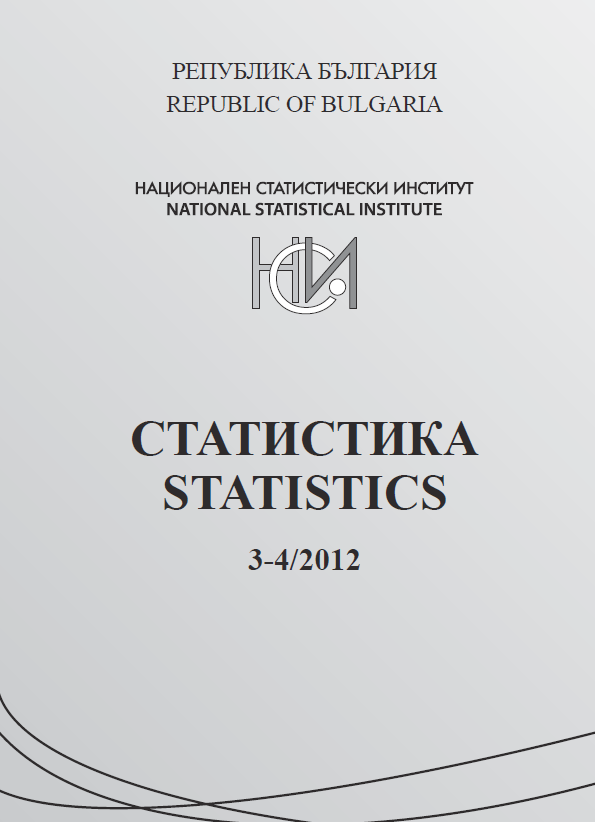National Statistical Institute of Bulgaria informs users of statistical information that the volume 3 - 4/2012 of Statistics Journal is available. The issue is only in Bulgarian (summary in English and Russian). In this volume are included the following chapters:
I. Theory and methodology of the statistical surveys.
II. Statistical surveys and analysis.
III. Historical development of the statistical theory and practice.
IV. Information, reviews, consultations.
International Year of Statistics 2013 (a leading article) - author Nikolay Yanev, Prof., PhD in Mathematics, Institute of Mathematics and Informatics at BAS.
І. In Theory and methodology of the statistical surveys, the following articles are published:
• Modeling returns to education and labour market outcomes of doctoral degree holders in Bulgaria - authors Ralitsa Simeonova-Ganeva, Chief Assistant at the Economic Faculty, Sofia University „St. Kliment Ohridski”, Natalia Panaiotova, PhD doctoral student at the Economic Faculty, Sofia University „St. Kliment Ohridski” and Kaloyan Ganev, Chief Assistant at the Economic Faculty, Sofia University „St. Kliment Ohridski”.
Here is presented the theoretical framework of the so called Mincerian equations used for modeling returns to education. Then, we construct a conceptual framework which allows us to answer the question “What happens to doctoral degrees on the labour market?”. We are analysing data for about 45 000 PhD graduates in Bulgaria from the NSI survey “Career development of PhD degree holders” run in 2007, 2008, and 2010. An attempt is made to measure pay gaps in terms of gender and major of study acquired. Using Mincerian equations, we calculate these pay gaps, thus we answer the question whether there are any income differences between doctoral degree holders. We find out that a doctoral degree in natural or technical sciences has a significantly higher pay-off than a degree in social or humanitarian studies. Another finding is that the greatest gender pay gaps are observed in social and humanitarian sciences while the smallest gap is in natural and technical majors.
ІІ. In Statistical surveys and analysis, the following articles are included:
• Evolution of inequality as a challenge to social policy - authors Vasil Tsanov, Prof., PhD, Economic Research Institute at BAS and Bogdan Bogdanov, PhD, Head of Households Income and Expenditure Department, NSI.
The article explores the evolution of inequality in Bulgaria in terms of household income, labor income, employment and unemployment, attained educational level and wealth. The results of the analysis can be used as a basis for further study of their impact on social, political and cultural processes in society.
The analysis of income inequality is focused not only on the overall dynamics but also on different parts of the income distributed (mostly either end of the distribution). Furthermore, the analysis involves various concepts of income: primary (market) income, income before and after social transfers and net income. This provides an opportunity to evaluate the role of social transfers and taxes on inequality.
• Demographic characteristics of the economically active in Bulgaria by educational categories according to population censuses in the period 1985 - 2011 - author Adraina Hristova, PhD student at the Institute for Population and Human Studies at the Bulgarian Academy of Sciences (BAS);
The main objective of the present research is to study and analyze changes in the structure of the economically active population of Bulgaria by education and major demographic attributes in the transition period to market economy. Both quantitative and qualitative characteristics of the active population are studied at national level by analysing changes in the number and educational structure of economically active population according to three demographic attributes: sex, age and place of residence.
The term ‘Educational structure’ is used in the study as a measure of the educational level of the economically active and employed population. According to it the economically active population is distributed into several groups depending on the level of education completed. Four education categories are introduced in the study: high, medium, low education and illiterate.
The changes in the educational structure of the economically active population were studied on the base of the system approach and the theory of labour force reproduction. They were examined using the traditional methods of statistical analysis for the study of two-dimensional distributions, when the main attribute is categorical.
• Census of Population and Housing Fund in the Republic of Bulgaria in 2011 - analysis of economic characteristics of the population (Reprint with cuts)
ІІI. In Historical development of the statistical theory and practice are presented analytical information on buildings and housing fund from the middle of the previous century until now:
• Main characteristics of the economically active population in Bulgaria (1900 - 1975) (Reprint with cuts) - author Dano Balevski.
• Population, Housing Fund and Farms Census in the Republic of Bulgaria in 2001 - analysis of economic characteristics of the population (Reprint with cuts).
ІV. In Information, reviews, consultations, the following information is published:
• NSI - partner in strategic international project for managing migration in South-East Europe - author Vesela Peicheva.
SEEMIG is a strategic project funded by the European Union’s South-East Europe Programme. The project aims to better understand and address longer term migratory, human capital and demographic processes of South-East Europe, as well as their effects on labour markets, national and regional economies. The main goal of the project is to empower public administrations to develop and implement policies and strategies by using enhanced datasets and empirical evidence. SEEMIG is managed by the Hungarian Central Statistical Office (Lead Partner of the project) and the partnership includes research institutes, statistical offices and local governments from eight countries (Austria, Bulgaria, Hungary, Italy, Romania, Hungary, Slovakia, Slovenia and Serbia).
